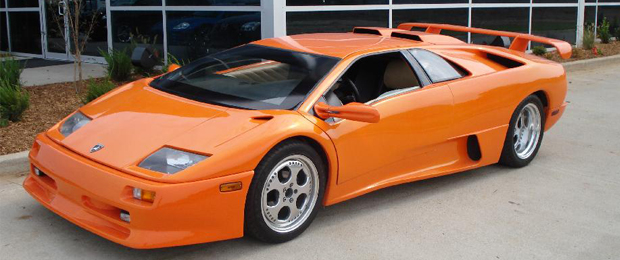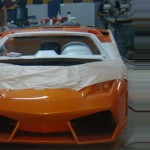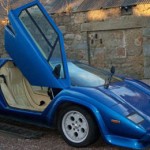 It’s a funny coincidence that two of Lamborghini’s signature sports cars, the Countach and Diablo, were the product of Marcello Gandini, a designer who wasn’t exactly on the side of the automotive gods – in this case Ferruccio Lamborghini, the founder of Lamborghini SpA. For reasons known only to Lamborghini himself, he looked at first design that Gandini did for Lambo, and was not exactly impressed.
It’s a funny coincidence that two of Lamborghini’s signature sports cars, the Countach and Diablo, were the product of Marcello Gandini, a designer who wasn’t exactly on the side of the automotive gods – in this case Ferruccio Lamborghini, the founder of Lamborghini SpA. For reasons known only to Lamborghini himself, he looked at first design that Gandini did for Lambo, and was not exactly impressed.
Lamborghini Diablo Replica Chassis
He was equally unimpressed with Project 130, later known as the Diablo, which was contacted to Gandini. Maybe the lines were too straight or the angles were too pronounced or maybe it was simply because they didn’t fit within Lamborghini’s vision, but, whatever the reason, Lamborghini was less than thrilled with the Diablo.
The funding they had lined up from Switzerland apparently had few problems with the concept, at least when it was commissioned in 1985. You see, the Diablo was to become the replacement of the Countach which had been Lamborghini’s flagship marque for more than a decade.
Lamborghini Diablo Replica Body
The Countach was not a vehicle one could overlook very easily as it had the famed “scissors” doors – doors that opened straight up and down – and it was the very first of the “wedge” vehicles of the 1970s and early 1980s when the auto industry jumped on that styling as its savior.
It was true that the wedge shape was wind-cheating, but, it had some inherent problems that anyone in the business could see if it was studied closely. The wedge itself, styled to take advantage of the supposed advantages of a bullet flying through the air, had a number of low pressure areas that exerted drag on the overall design, despite the best efforts of the manufacturer to eliminate them. The wheel wheels, though flush, still exerted drag as did the wind coming off the sharply raked windshield. The small cross-section front end was great, but it did lead to very straight sides that, again, could cause some low pressure drag areas, while the rising roofline, no falling away, also led air turbulence up and over the sloping rear window. Still, for its time, the Countach had impressively low drag numbers and it must have been successful because it last in products for 11 years, almost unchanged.
Lamborghini Diablo Replica Interior
The Diablo was another story. In the mid-1980s Lamborghini was bleeding money from just about every orifice you could think of. Its products were aging and new product plans were running behind because of money troubles investors were running for cover. The savior, at this moment, was the then well-heeled Chrysler Corp., which had started the minivan revolution not too many years before and was putting out competitive vehicles. It had a war chest and was looking for a way to compete in the airy world of high-performance vehicles. Ford and Shelby had inked a deal behind the scenes and General Motors had its Corvette marque to fight the good fight, but Chrysler wanted a super-arrow in its quiver and it chose Lamborghini in 1987, taking over the investment position that Swiss developers had occupied.
The only problem was that Chrysler, as insiders put it, didn’t like the lines of the Gandini-inspired Diablo and they decided to put their money into a new restyling, which, of course, didn’t set too well with the original designer, who saw his vehicle on the road as The Cezito-Moroke VT16, but that’s another story.
Chrysler wanted the sharp corners rounded and wanted the design to blend more with the rounder concept that had taken hold in late 1980s Detroit. The wedge was still there, it just wasn’t obvious, and it had to be rounded and stylish. The result worked because the Chrysler-inspired Diablo was on the road from 1990 to 2001.
It set a couple of marks:
It was the first Lambo that approached the 200-mph mark on the street, using the same mid-engined V-12 layout
It was the first vehicle acknowledged as a “man’s car” – it was built by driving men to be driven by driving men. In other words, it was an engine with a monocoque frame and sheet, yet it eschewed such niceties as power-steering, air conditioning and even electric windows. It’s windows were fixed and there were sliders in the front if you wanted any circulation
Still, total production ended up at well over 1,000 when the last of the original-design Diablos rolled off the line at San’ta Agata.
Today, if you are looking for a Diablo, all you need to do is Google the terms Diablo and replicar or kit and you will be presented with sites all over the place that promise you kits made from a Fiero frame or an MR2 frame or from a specially constructed frame that is made for a vehicle such as the Diablo 6 which is online and eschews using the frames of other vehicles.
In all honesty, building a kit car is a risky business because you may or may not have the tools or expertise to do the work.
If you have the expertise, the best frames to work from are probably the Pontiac Fiero – a mass-produced mid-engined car from Pontiac made in the late 80s. You are in luck that about 365,000 of them were built. Or, you can use the Toyota MR2, built in the same time frame. About 120,000 of them were built. They both have the advantage of being mid-engine models which does make it easier.
Here’s where the fun begin because, if you do the math, unless you run across on that was maintained in showroom condition, the chances are good that you will find that the frame, assuming you can buy the frame without a car attached, probably needs a good cleaning, once you have the body off. For that, we’d leave it to the experts and that’s a job that can cost upwards of $10,000 to $15,000 to do the body removal correctly.
If you are lucky and have found just the frame – with the body already gone – you are looking at a cost of about $35,000 for the frame alone.
Then there’s the choice of the engine. Many kit-builders take the easy way out and use the engines that were already built into the frames in the first place, but, if you are looking for authenticity, you will have to find a 5.8-liter small V-12/transmission/differential assembly and then, providing you have the tools, garage space and expertise, you will have to shoehorn the assembly into the frame.
Oh, and then there’s the matter of the rear driveshaft in these rear-drive cars and the front suspension (coil-over-strut, so you are in luck, provided you have a good coil compressor and the right mounting tools).
Assuming you have correctly mounted the rear driveshaft (four main bearings) and rear banjo box (planetary gearing that allows the rear wheels to push forward), allowing for any bracing and other work to be done, you’re almost ready to run the start the body assembly.
Assuming you have the right kit and the right clamps so that you can assure a good tight fit between the fiberglass body panels and the frame, as well as the right adhesives and any accessory nuts and bolts, you’ll still need a trusty torpedo level to make sure your panels are straight and square and that the seams are tight without huge gaps.
Are you beginning to see a pattern here? The bottom line is that unless you are an expert at car restoration of replicar building, it makes sense to put down the cash and let the pros do it for you. You’ll have a better product for it and you will save untold time (and who knows how many trips to the emergency room) in the end.
What will it cost? The original Diablo was an expensive machine so if you are looking for a quality replicar or kit (use Google and /or the clubs for reference) you’re still looking at the price of a small (very small) condo, or about $150,000, when all is said and done – that’s if you want the job done right.
If you don’t care how it comes out, then you can probably find someone on Ebay who will sell you a weirdly built kitcar Diablo for $40,000 or so. Will it run? Will it even have straight seams? Well that’s a good question and only you can answer it.
Image: brandnewmusclecar.com

































Leave a Reply
You must be logged in to post a comment.